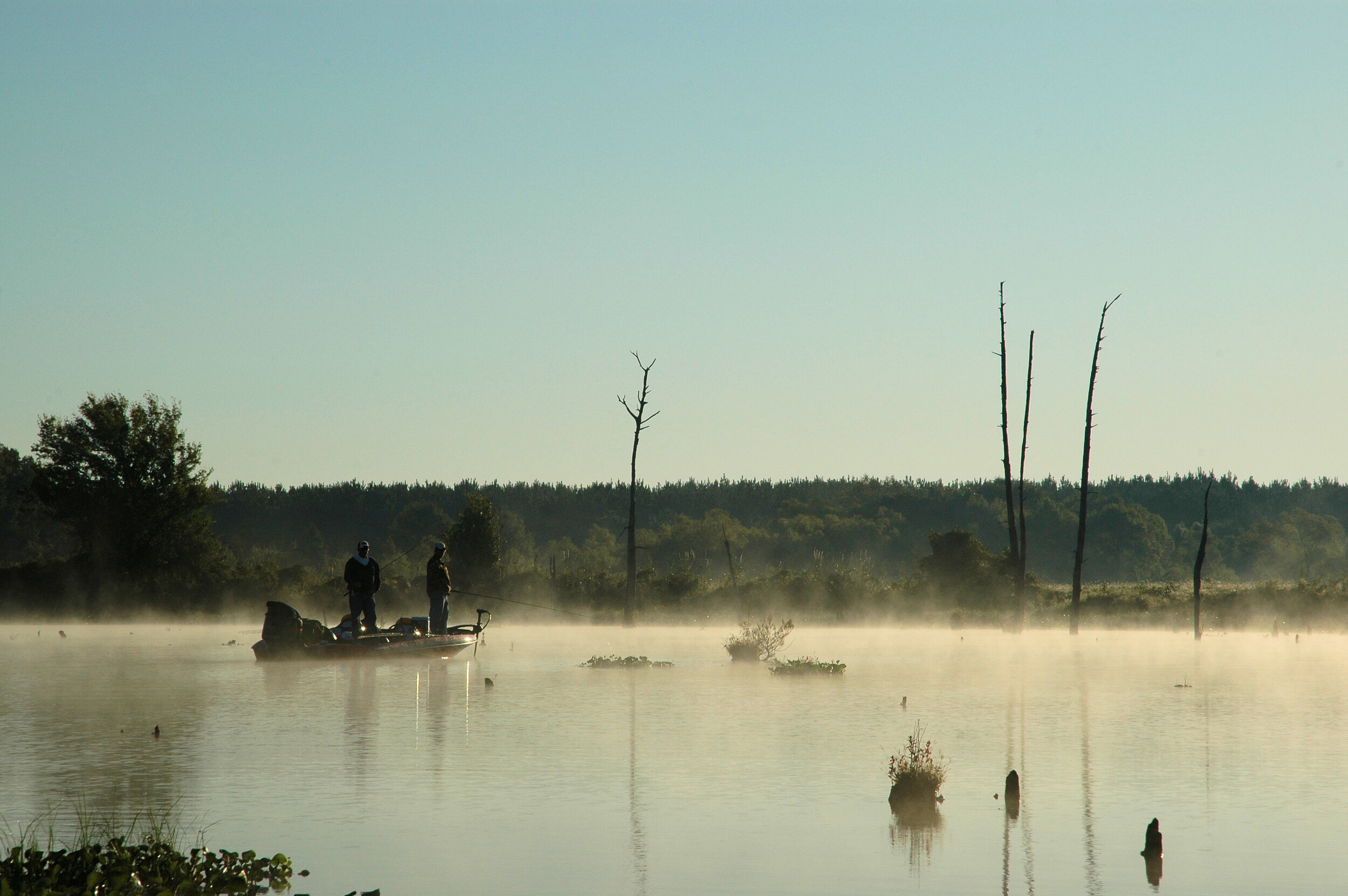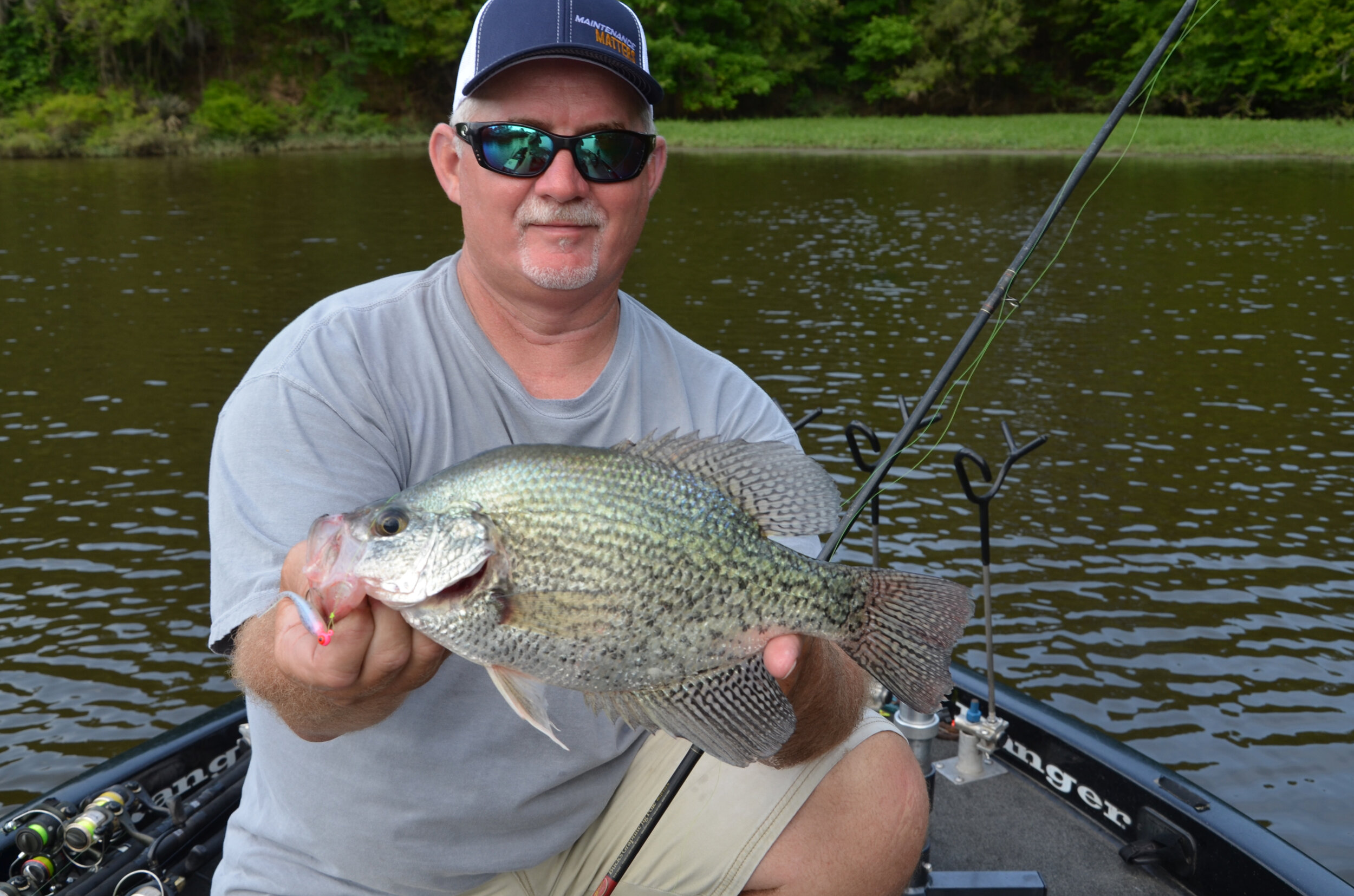One-On-One Crappie Fishing: Single Pole Techniques Add To The Fun
By: John N. Felsher
In the spring, crappie spawn in great numbers around shallow structures such as standing timber, logs or stumps. When crappie congregate in small places, anglers can enjoy a fun day fighting them one on one.
“I like to fish with a single rod and one bait,” remarked Jo Haley, a professional crappie angler from Illinois. “With one pole in hand, I can detect subtle bites when fish hit really softly. Sometimes, I can’t even feel the bite. I just watch the line for a slight change. If it goes slack or something else, I set the hook.”
Standing timber punctuates many reservoirs. In much of the South, cypress trees and their associated “knees” dominate the cover. Cypress trees commonly grow in water up to seven feet deep. In other waters, anglers might look for spawning crappie around dock or bridge pilings, fallen trees, rocks, weed patches, brush and other cover.
Steve Coleman, a professional crappie angler from Tiptonville, Tenn., shows off a white crappie he caught while fishing a single-pole rig in a backwater off the Tennessee-Tombigbee Waterway near Columbus, Miss. (Photo by John N. Felsher))
“On just about any lake, anglers can find stumps, laydowns, stake beds, flooded timber and other structure that attract crappie,” Steve Danna advised. “My favorite way to fish structure is with a single pole.”
Danna, a professional crappie angler, designed his own pole, a B’n’M Tree Thumper, just for this type of fishing. He frequently fishes standing trees for slab crappie in the cypress-studded Lake D’Arbonne near his north Louisiana home.
Most crappie enthusiasts fish jigs. Some people sweeten their jigs with live minnows. Danna tips his line with a 2- to 2.5-inch soft-plastic trailer on a 1/16- or 1/8-ounce jighead and adds a Berkley Crappie Nibble. He fishes jigs on 6-pound-test high visibility line and watches the line carefully to detect even the slightest strike. Sometimes, the line jumps a bit or it could just feel heavy. Either could indicate a strike.
“I’ll never put a jig in the water without a Crappie Nibble,” Danna stated. “Single-poling is not only a great way to catch fish, but it’s also a lot of fun. I love feeling that thump. I’ve won many tournaments by single poling.”
To find spring crappie, Danna slowly pushes his boat forward, barely using the trolling motor. He stealthily approaches cypress trees or other objects sitting in two to five feet of water. Fish in shallow water can spook easily. The clearer and shallower the water, the more easily a moving boat, shadow or unnatural sound can chase fish from their spot.
With a long pole in each hand, Danna carefully swings a lure so that it lands as close to the object as possible. He wants the enticement to enter the water with barely a ripple. Crappie holding tight to cover won’t stray far from it to chase baits.
“When I’m single poling, I fish the jig straight up and down,” Danna commented. “I keep the line vertical while just barely moving my boat. I don’t move the jig at all. I do not believe in jerking a jig up and down.”
Let the bait sink naturally. If nothing happens as the bait sinks, drop it into another spot, perhaps only inches away. Carefully probe every possible hiding place. For whatever reason, crappie may prefer one side of cover or another. That could change throughout the day.
Tim Blackley, a professional crappie angler, shows off a crappie he caught on a jig while fishing at Arkabutla Lake near Hernando, Miss. Anglers can drop jigs next to stumps, standing timber, pilings and other cover to catch big crappie.(Photo by John N. Felsher)
Maybe a tiny spring bubbles up in one spot, adding more oxygen to the water or holding temperatures at comfortable levels. Perhaps unseen submerged cover creates an excellent place to ambush bait. In cold water, fish generally stay on the sunny side of structure. As the water warms, they might move into the shade.
Anglers may never know the reason, but fish do. Therefore, hit every object or pocket from many different angles to pattern where crappie want to stay at that time. If possible, fish completely around any tree, stump or other vertical objects sitting in deeper water.
“We always fish a single-pole rig around really thick cover,” said Gerald Overstreet, Jr., a professional crappie angler and guide from Gainestown, Ala. “We can work a single bait through the really thick stuff all the way down and pull hooked fish out easier than with other techniques.
In rivers or other systems with current, crappie don’t like to fight the flow, but regularly stay near the edge of it. Therefore, look for crappie behind any current breaks such as fallen logs or standing objects. In tidal rivers, currents could change direction throughout the day with fish switching positions accordingly.
In a strong wind or current, anglers might add a small slip sinker or attach a tiny split-shot about six to eight inches above the bait. Always use the lightest weight possible so the temptation sinks naturally.
Gerald Overstreet with Overstreet’s Guide Service in Gainestown, Ala. shows off a crappie he caught on a jig tipped with a plastic trailer while fishing the Alabama River near Montgomery, Ala. Anglers can drop jigs next to structure to catch big crappie in the spring. (Photo by John N. Felsher)
“The weight of the bait we use depends upon the current,” Overstreet explained. “I like a 1/16- or 1/8-ounce jighead. In really strong current, I go to a 1/4-ounce jighead to hold the bait in the strike zone.”
When tempting finicky fish or on a calm, quiet day, try flies or hair jigs. These enticements make very subtle action. Often, just the boat rocking provides enough movement to provoke a strike. Even when holding a rod perfectly still, the slightest water current could still make the hairs on a fly or jig quiver and twitch seductively.
“With a hair jig, people don’t need to add a lot of extra action,” opined Jarad Roper, a professional crappie angler from Arkansas. “A hair jig can take on a little more lifelike action than plastic, but it’s very subtle action, good to use when fish are not acting aggressively. Just the twitching hairs could be enough for the fish to want to commit to a bite.”
Although anglers normally fish with single poles in the spring, the technique can catch fish all year long. In the fall, crappie often feed around shallow structure. In the summer, probe shady cover, like under docks. Anglers who find the right spot and figure out the right bait combination can put many fish in the boat quickly and enjoy incredible fun doing it.
Have you done something interesting outdoors? Join Global Outdoors and write a review to tell everyone about it! We’re building the home for trusted reviews of outdoor experiences, outfitters, and guides. Help us out and you’ll be entered to win free trips!





